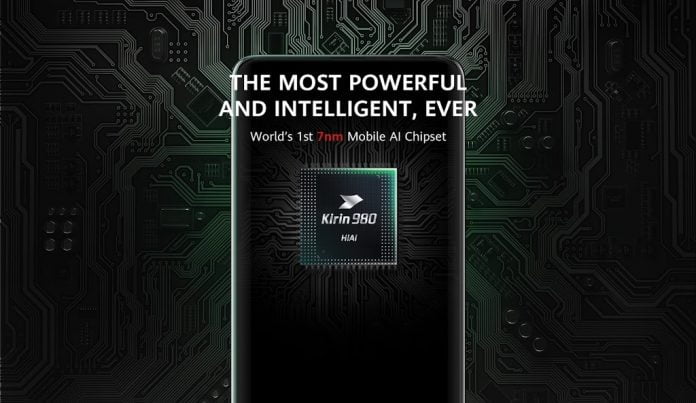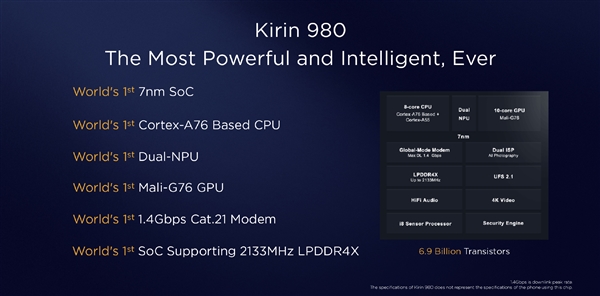Huawei released a new generation of SoCs at the IFA 2018 event. This time in addition to pushing the SoC process to 7nm, the Huawei Kirin 980 has many innovations and features.
The processor part is ARM Cortex-A76 + ARM Cortex-A55 processor architecture, but different from the previous 4 + 4 configurations this Huawei Kirin 980 processor configuration is 2 core ARM Cortex-A76 2.6GHz (Turbo) + 2 Core ARM Cortex-A76 1.92GHz (Performance) + 4 core ARM Cortex-A55 1.8GHz (Power Efficiency).
Instead of opting for larger core configurations and smaller ones, opt for a three-step system to try to adapt as best as possible to all the power needs a smartphone might need.
When running the game all cores will be launched and when executing some community software, the 1.92GHz middle core will start.
As for the low-load app using music software, the Huawei Kirin 980 will only launch one of the power-efficient Core.
The GPU part is the ARM Mali-G76 10 core configuration, followed by Huawei’s so-called GPU Turbo technology. Compared with the Kirin 970, the performance increased by 46% while the efficiency part increased by 178%.
We are quite aware that the current Qualcomm Snapdragon 845 GPU has certain advantages and the Huawei Kirin 980 will certainly find it for comparison. For the Kirin 980 press conference to compare NBA2K18 games the average FPS of the Huawei Kirin 980 can reach 59.3 while the average FPS of the Qualcomm Snapdragon 845 is only 48.5. The average power consumption per frame of the NBA2K18 is 64.5mW/frame of the Qualcomm Snapdragon 845 and 43.7mW/frame of the Huawei Kirin 980.
However, Huawei did not disclose which Qualcomm Snapdragon 845 device to use for testing.
In addition, when using the PUBG Mobile game for GPU Turbo testing, the average FPS of the Huawei Kirin 980 is 58.8, the Qualcomm Snapdragon 845 and the Huawei Kirin 970 are 54.1 and 58.2 respectively; the average power consumption per frame is 38.7mW of the Kirin 980 respectively. /frame, 42.9mW/frame for Kirin 970 and 45.2mW/frame for Qualcomm Snapdragon 845.
If you don’t discuss power consumption, the Kirin 980 doesn’t seem to be able to compete with the Kirin 970 without turning on the GPU Turbo, but from the average power consumption per frame provided by Huawei, the so-called GPU Turbo seems to be helpful.
The Huawei Kirin 980 is the first SoC to support LPDDR4X 2133MHz memory; the benefits of supporting LPDDR4X 2133MHz are 20% higher bandwidth and 20% lower than the Qualcomm Snapdragon 845 LPDDR4X 1866MHz; the UFS 2.1 specification is supported in the storage section.
The new Dual ISP (Image Signal Processor) configuration is 46% faster than the previous version and improves recording efficiency by 23% and 33% improvement in recording delay; of course, better low-light noise which performed.
Followed by AI but in this section, there is no certain test standard at this stage. The Huawei Kirin 980, paired with a dual-core NPU, claims to be about twice as powerful as the Qualcomm Snapdragon 845.
The LTE Cat. 21 Modem is now ahead of the LTE Cat. 18 specification of the Qualcomm Snapdragon 845.
It is important to note that the Huawei Kirin 980 LTE Cat. 21 specification Modem achieves 1.4 Gbps through 4×4 MIMO + 256 QAM + 3 x 20 MHz CA, while the download portion is 2×2 MIMO + 256QAM + 1 x 20 MHz CA 200Mbps for the LTE Cat. 18 specification.
With the Kirin 980 with Huawei Hi1103, Huawei provides Wi-Fi test data of 1732 Mbps, while the Qualcomm Snapdragon 845 has only 866 Mbps with its own Wi-Fi module.
From the specifications and the data provided by Huawei, the Huawei Kirin 980 is quite amazing and then it is the arrival of the Qualcomm Snapdragon 855 SoC. It is confirmed that Qualcomm will release a new one in Hawaii in December.










